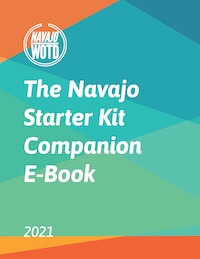Navajo pronunciation and grammar notes
Things you may notice as a student of the Navajo language
Today we’ll shed light on a few things you might notice in reading Navajo.
It wasn’t until the early 1900s that the Navajo language was somewhat thoroughly documented. Written Navajo still has a few differences stemming from these early efforts, mainly in style.
Glottal mark
Vocally, words that begin with a vowel, like e’e’aah, automatically have a glottalized pronunciation. This means that you cannot slur your words into each other. Some texts will remind you by inserting the glottal mark on every vowel-leading word, like so: ‘e’e’aah. The pronunciation stays the same between both styles, but depending on the author of the Navajo text, it can vary.
ni- vs. n- (ní- vs. ń-)
This is another style choice introduced to ease new speakers into Navajo. Take nít’éé’ (meaning it was, or it used to be). Some texts will shorten this word to ńt’éé’. It may be confusing, at first, but the latter spelling and vocalization is common when speaking smoothly, or fast. The ‘í’ becomes less vocalized in cases like this. Which leads us to our next point..
i and a, weak
In certain words with i and a as a first vowel (following a consonant), speaking quickly can change how they’re vocalized. Remember bíhoosh’aah? If a speaker chooses, it can also be bóhoosh’aah. You’ll notice that the í morphed into an o to fit the flow of the following oo. In this case, the í was weak and the oo was dominant. So, you may see verb forms that are written as such.
aa-, ee-, ii-, oo- followed by a consonant
Long vowels followed by a consonant have a nasal quality, automatically. They could have nasal tones in such cases. For example -aan could also be -ąąn. For the word asdzaan, asdząąn is also acceptable. This is simply an understanding of how long vowels interact with consonants like n, so it’s likely that you’re already nasalizing those vowels without the extra marks.
Original post date: .
